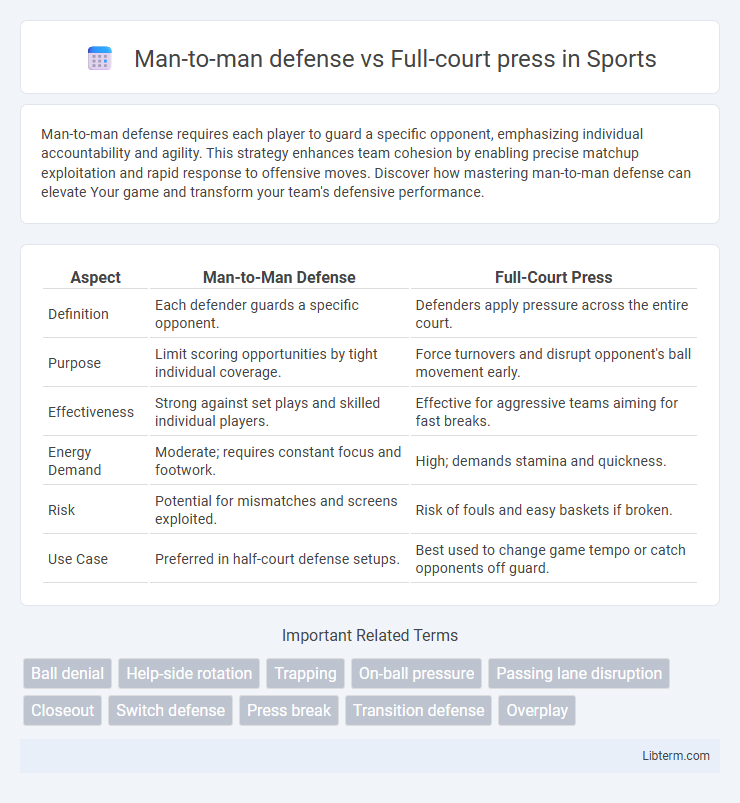Man-to-man defense requires each player to guard a specific opponent, emphasizing individual accountability and agility. This strategy enhances team cohesion by enabling precise matchup exploitation and rapid response to offensive moves. Discover how mastering man-to-man defense can elevate Your game and transform your team's defensive performance.
Table of Comparison
| Aspect | Man-to-Man Defense | Full-Court Press |
|---|---|---|
| Definition | Each defender guards a specific opponent. | Defenders apply pressure across the entire court. |
| Purpose | Limit scoring opportunities by tight individual coverage. | Force turnovers and disrupt opponent's ball movement early. |
| Effectiveness | Strong against set plays and skilled individual players. | Effective for aggressive teams aiming for fast breaks. |
| Energy Demand | Moderate; requires constant focus and footwork. | High; demands stamina and quickness. |
| Risk | Potential for mismatches and screens exploited. | Risk of fouls and easy baskets if broken. |
| Use Case | Preferred in half-court defense setups. | Best used to change game tempo or catch opponents off guard. |
Introduction to Basketball Defensive Strategies
Man-to-man defense assigns each player to guard a specific opponent, emphasizing individual accountability and close pressure to limit scoring opportunities. Full-court press extends defensive pressure across the entire court, aiming to disrupt the opponent's offensive rhythm and force turnovers through aggressive trapping. Both strategies require high stamina and communication but differ in spatial coverage and tactical objectives within basketball defense.
Understanding Man-to-Man Defense
Man-to-man defense involves each defender being responsible for guarding a specific opponent, emphasizing individual accountability and close, physical coverage to limit scoring opportunities. This strategy requires strong communication, quick lateral movement, and the ability to anticipate the ball handler's actions, making it effective against teams with versatile scorers. Understanding man-to-man defense highlights the importance of positioning, defensive footwork, and teamwork to disrupt offensive plays and force contested shots.
What is Full-Court Press?
Full-court press is a defensive basketball strategy where the defending team applies pressure to the offensive players across the entire court, aiming to disrupt their play and force turnovers. It contrasts with man-to-man defense, which concentrates on guarding individual opponents primarily in the half-court area. By aggressively challenging ball handlers and passing lanes throughout the full length of the court, full-court press can create fast-break opportunities and increase defensive intensity.
Key Differences Between Man-to-Man and Full-Court Press
Man-to-man defense assigns each defender to guard a specific opponent, emphasizing individual matchups and spatial positioning to limit scoring opportunities. Full-court press applies intense pressure across the entire court, aiming to disrupt ball handlers, force turnovers, and accelerate the opponent's offensive pace. Key differences include man-to-man's focus on direct coverage and containment versus full-court press's strategic pressure and increased defensive aggression throughout the playing area.
Advantages of Man-to-Man Defense
Man-to-man defense allows defenders to closely guard specific opponents, increasing accountability and reducing open scoring opportunities. This strategy improves defensive communication and helps players develop better individual skills by focusing on their matchups. Unlike full-court press, it conserves player energy and minimizes fouls by maintaining position rather than constant pressure across the entire court.
Benefits of Implementing a Full-Court Press
Implementing a full-court press enhances defensive pressure by disrupting opponent ball handlers across the entire court, leading to increased turnovers and fast-break opportunities. This aggressive defense exploits opponents' ball-handling weaknesses and stamina limits, forcing hurried decisions and errors. Effective full-court pressing also improves team communication and conditioning, creating a high-intensity game tempo that can mentally and physically wear down adversaries.
Situational Effectiveness: When to Use Each Defense
Man-to-man defense excels in situations requiring tight individual coverage, particularly effective against teams with strong perimeter shooters or when precise matchup control is needed. Full-court press is most effective in high-pressure scenarios, such as late-game situations or against teams with weaker ball-handling skills, aiming to force turnovers and disrupt the opponent's offensive rhythm early. Coaches often deploy man-to-man defense in half-court settings for consistent containment while reserving full-court press to create urgency and capitalize on opponent mistakes.
Common Challenges and How to Overcome Them
Man-to-man defense often struggles with maintaining tight individual coverage, leading to breakdowns against quick ball movement, while full-court press challenges include player fatigue and increased risk of defensive breakdowns. To overcome these, teams should emphasize constant communication and situational awareness in man-to-man defense, alongside strategic substitutions and conditioning for sustaining intensity in full-court press. Implementing systematic trapping techniques and practicing quick rotation drills can further mitigate vulnerabilities in both defensive strategies.
Famous Examples in Basketball History
Man-to-man defense, famously employed by the 1995-96 Chicago Bulls, showcased relentless individual guarding that contributed to their historic 72-win season. The 1979 Michigan State Spartans, led by Magic Johnson, utilized a full-court press to disrupt opponents' offensive flow, securing the NCAA Championship. Both defensive strategies have been pivotal in shaping championship-winning teams by emphasizing either tight individual coverage or aggressive, team-wide pressure.
Choosing the Right Defense for Your Team
Choosing the right defense for your team depends on player skills and game tempo, with man-to-man defense offering personalized coverage and better individual accountability. Full-court press applies intense pressure across the entire court, ideal for teams with high stamina and quickness to force turnovers early. Evaluating your roster's speed, stamina, and ball-handling will guide the strategic decision between defensive styles that maximize team strengths and control game flow.
Man-to-man defense Infographic

 libterm.com
libterm.com